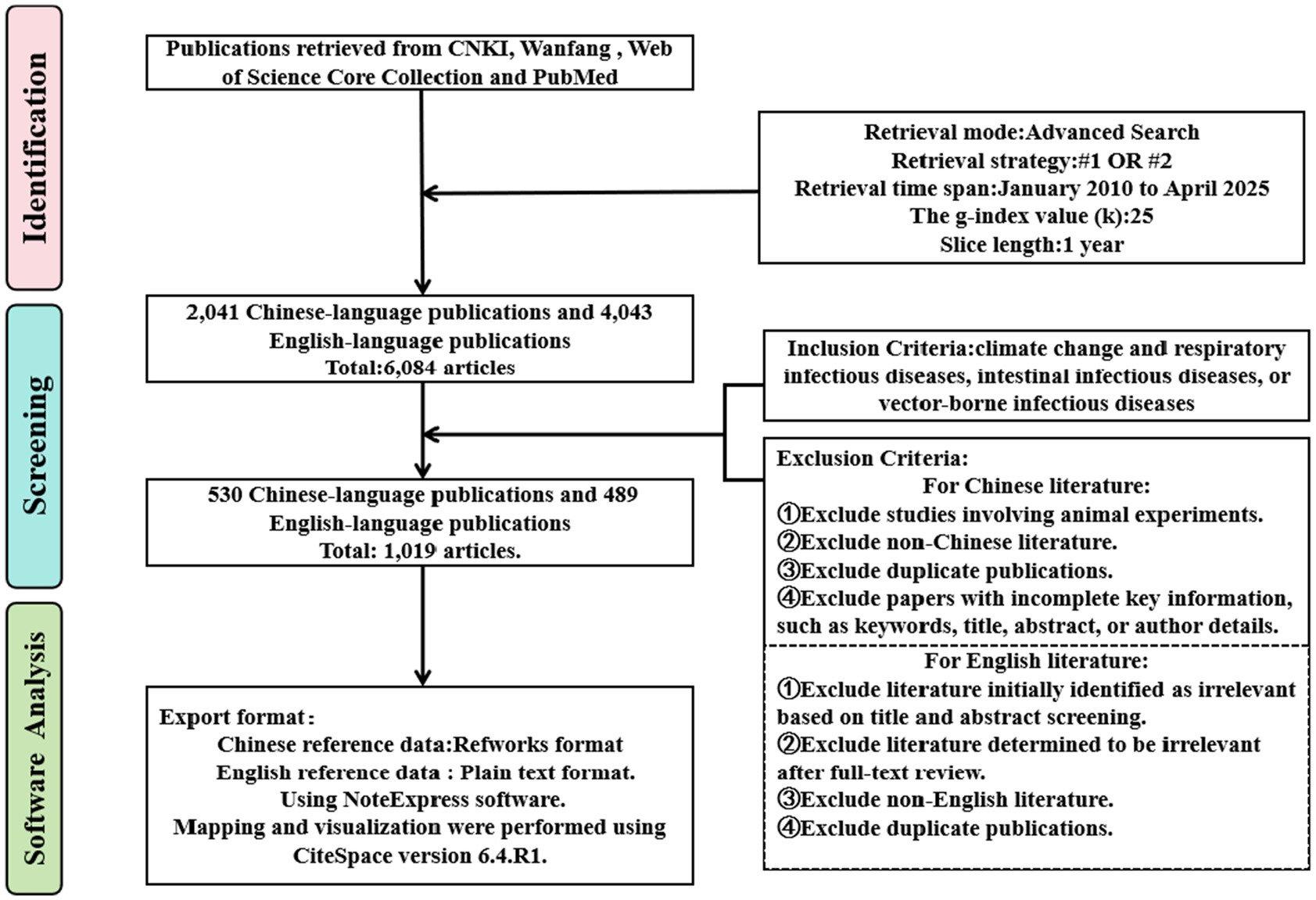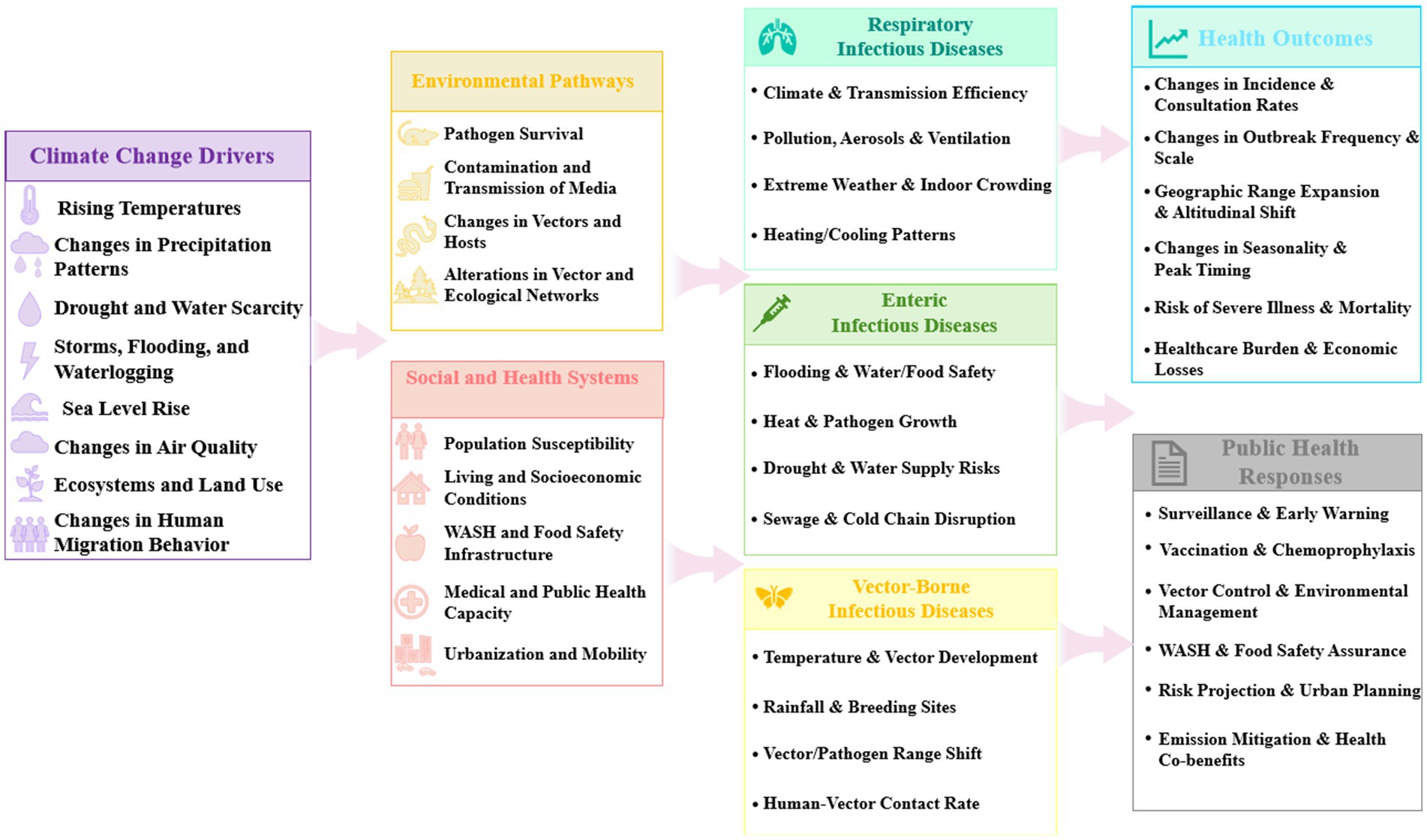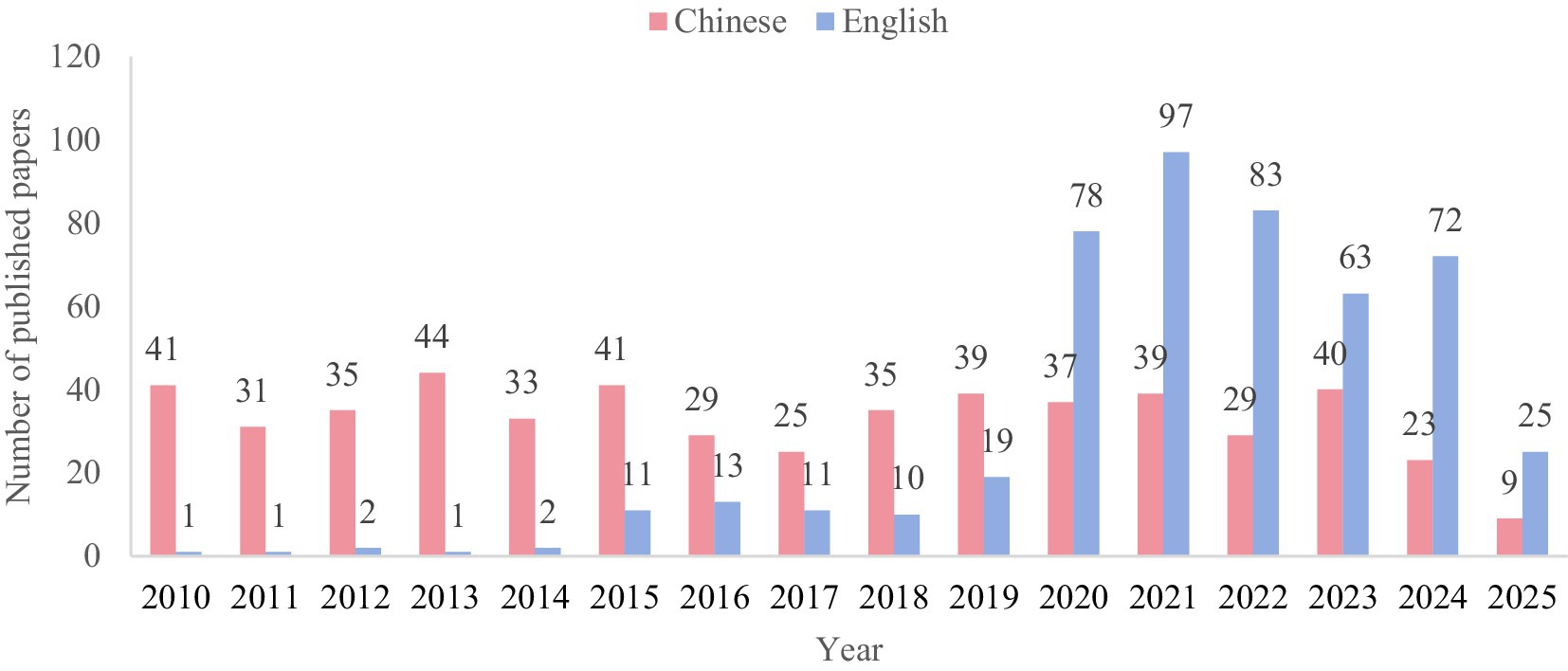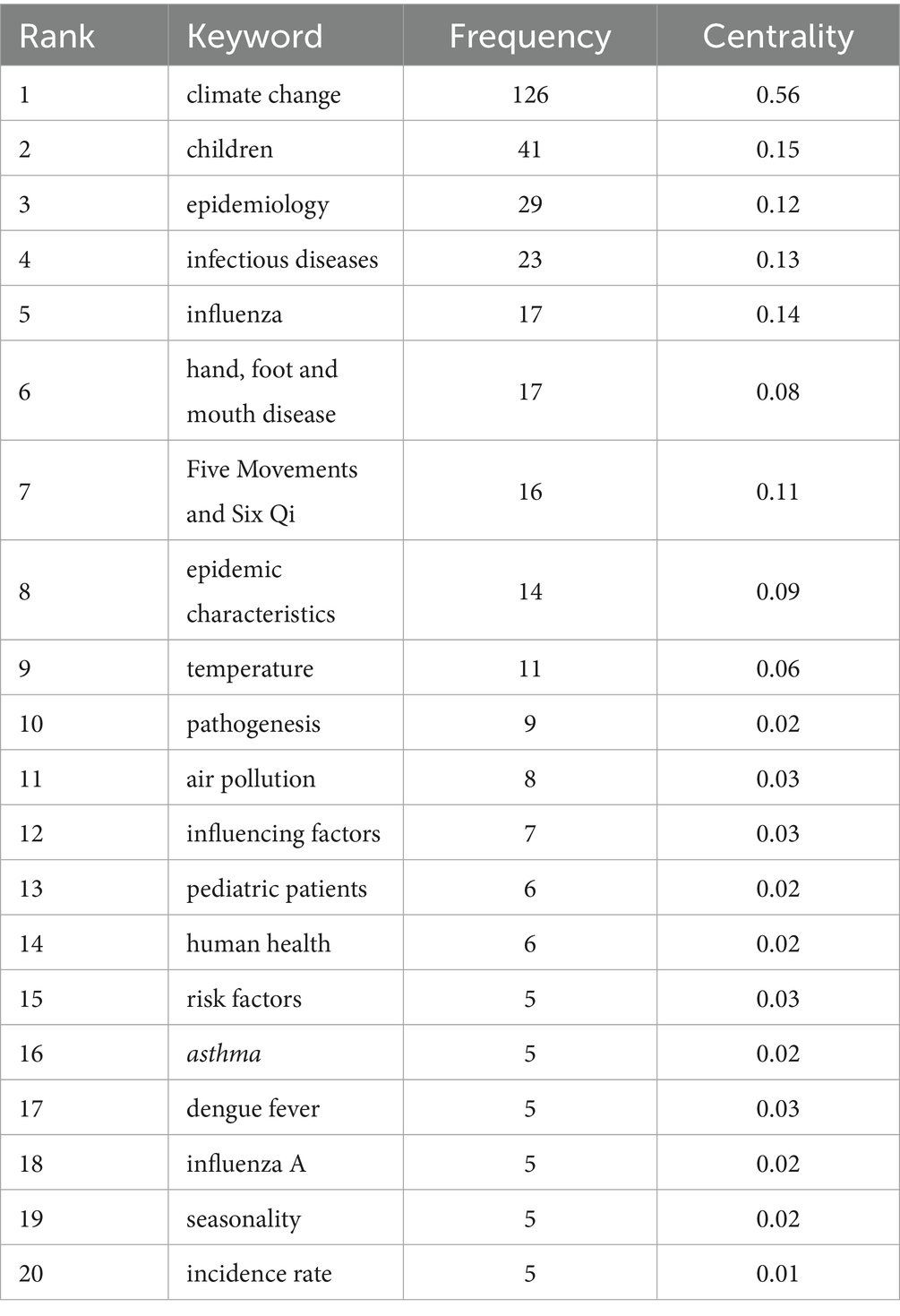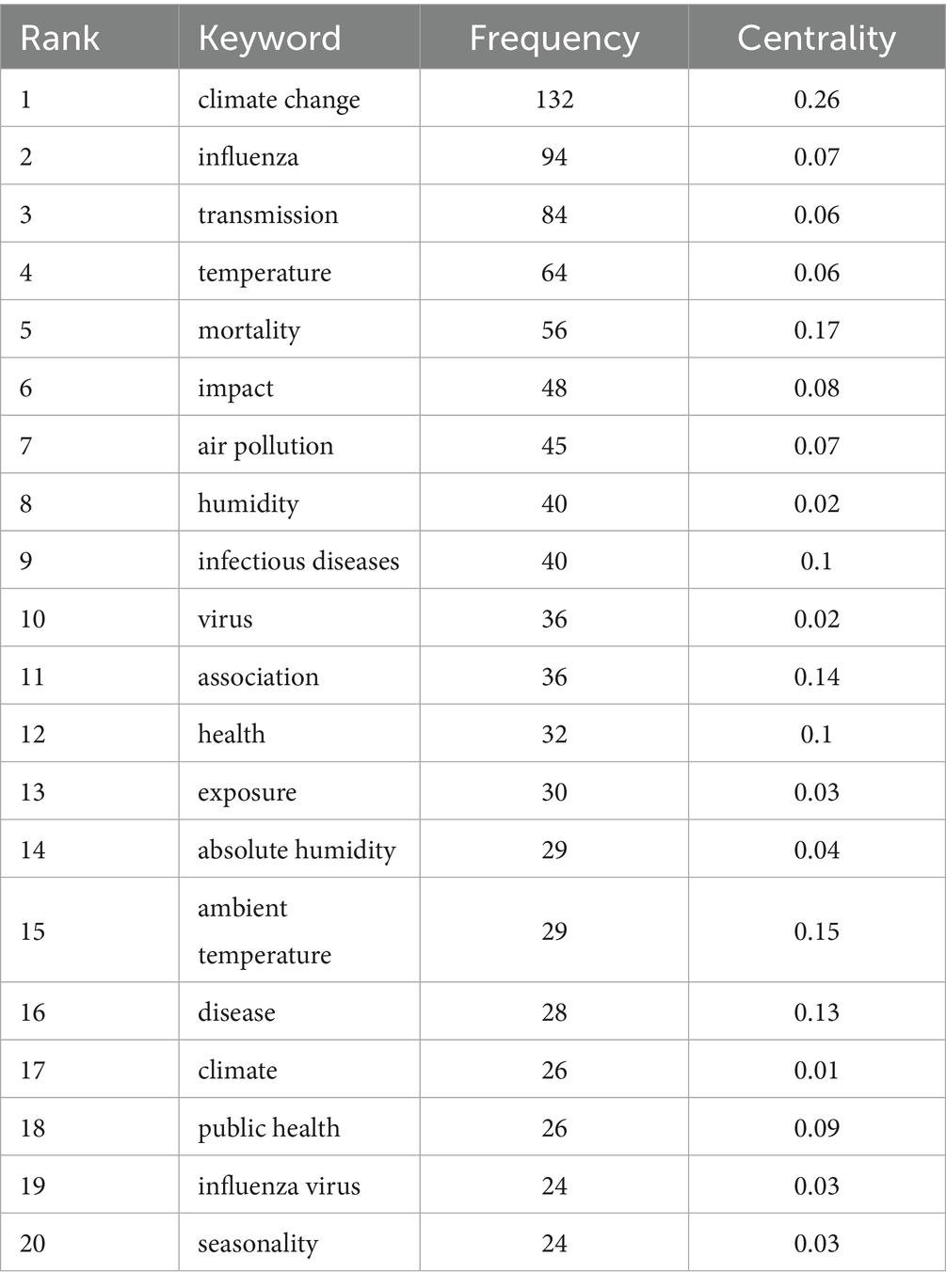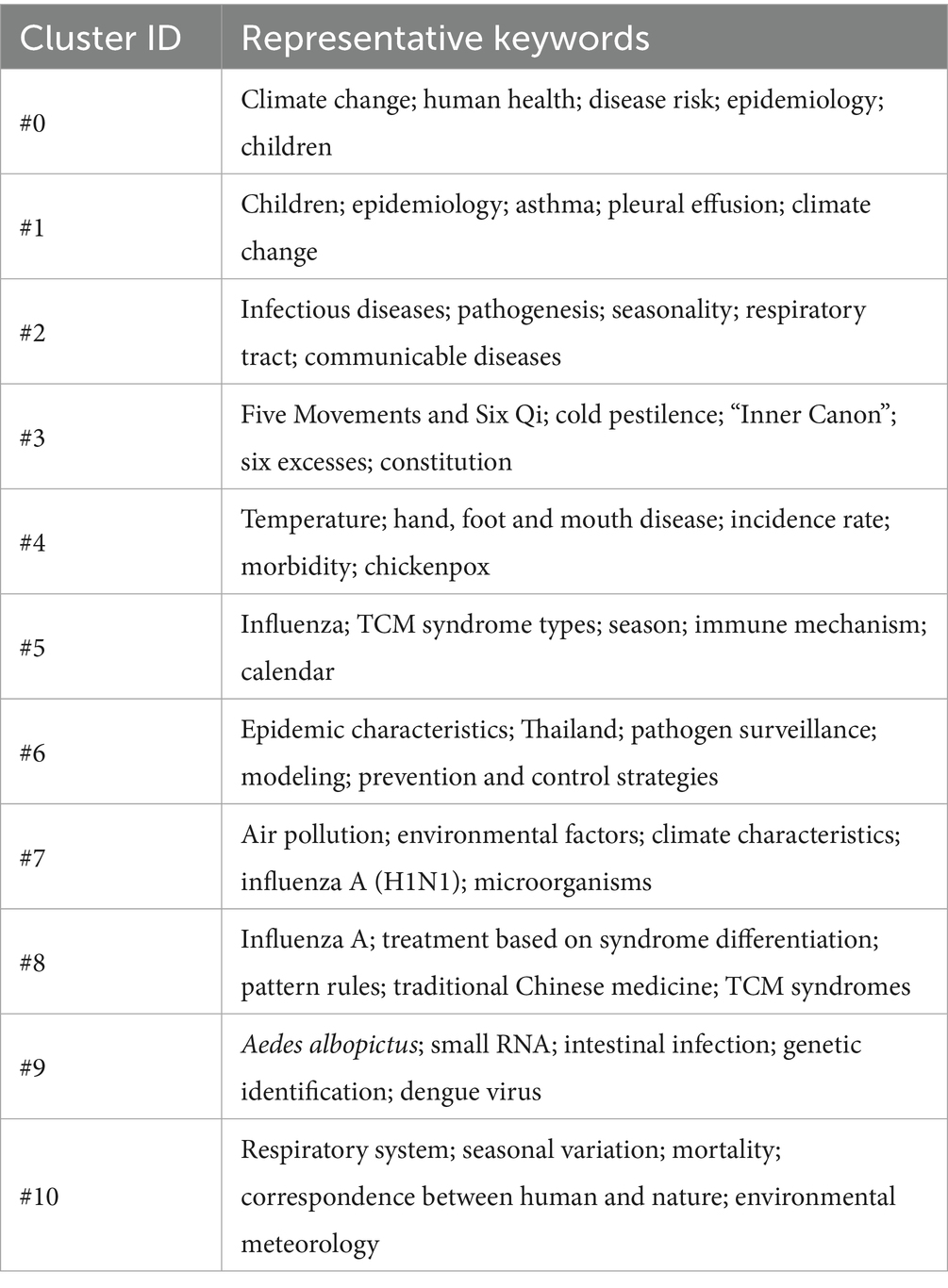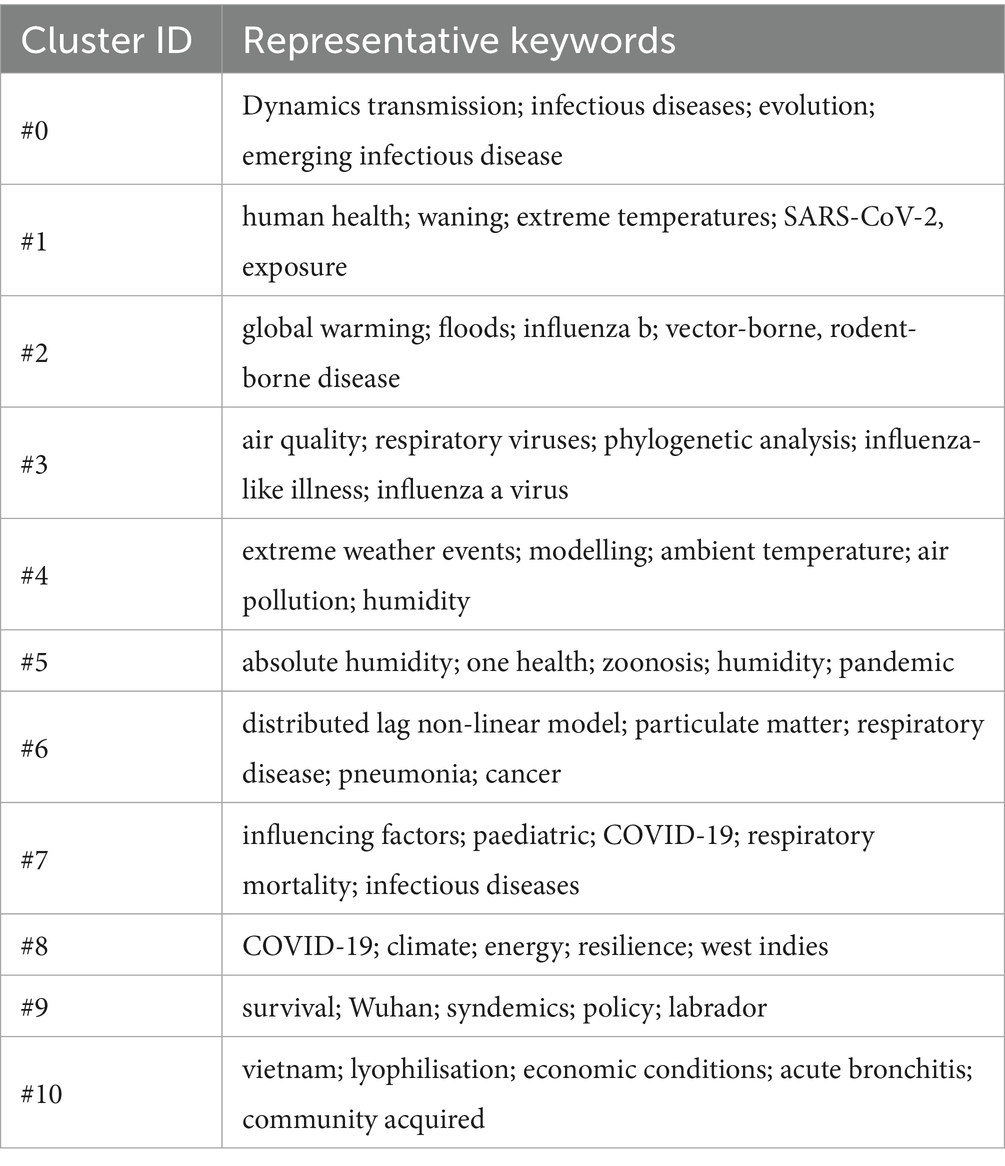- School of Informatics, Hunan University of Chinese Medicine, Changsha, China
Objective: This study aims to address the research gaps in understanding the connections between climate change and infectious diseases by integrating bibliometric analysis with epidemiological perspectives and systematically identifying research trends and thematic evolution in this field.
Methods: We conducted a comprehensive bibliometric analysis of literature published between January 2010 and April 2025, retrieved from Web of Science, PubMed, CNKI, and Wanfang databases. Analytical methods included keyword co-occurrence mapping and cluster analysis using CiteSpace and VOSviewer.
Results: The analysis revealed a steady increase in publication output, accompanied by a notable shift from single-disease studies to complex system assessments. Research patterns showed distinct thematic priorities: vector-borne diseases demonstrated significant growth after 2018; respiratory infections maintained consistent research attention, while enteric diseases received comparatively limited focus. These patterns reflect underlying socioeconomic disparities and regional climatic influences.
Conclusion: This study underscores the need for more systematic research on the intersection of climate change and infectious diseases. Future work should develop multi-disease analytical frameworks, advance interdisciplinary methods integrating environmental and data sciences with public health, and strengthen global research networks by improving geographic coverage and data standardization. These efforts will enhance predictive capabilities and intervention strategies against climate-sensitive infectious diseases.
1 Introduction
In recent years, the impact of global climate change on the epidemiology of infectious diseases has emerged as a critical public health issue (Phung et al., 2025). Against a backdrop of rising temperatures, increasing frequency of extreme weather events, and ecosystem transformations, significant alterations have been observed in pathogen transmission dynamics, host distribution, and human exposure risk (Wang et al., 2024). Research on human pathogenic infectious agents indicates that approximately two-thirds are sensitive to climate (Baker et al., 2022). Factors such as global warming, altered precipitation patterns, and the increased occurrence of extreme weather events can influence the survival, reproduction, and distribution of pathogens, vector organisms, and intermediate hosts, thereby elevating the risk of infectious disease transmission. The transmission patterns of specific diseases, particularly respiratory infectious diseases (such as influenza and COVID-19), enteric infectious diseases (such as cholera and norovirus infection), and vector-borne diseases (such as malaria and dengue fever), are closely associated with climatic factors (Semenza et al., 2022). For instance,variations in temperature and humidity can prolong the active season of mosquito vectors; flooding can facilitate the spread of enteric pathogens through contaminated water sources; concurrently,climate warming and air pollution may alter the survival stability of respiratory viruses and the defensive capacity of individual respiratory systems, consequently increasing the risk of viral transmission.
Classical texts of Traditional Chinese Medicine (TCM) provide systematic interpretations of the connection between climate change and infectious diseases. The Yellow Emperor’s Inner Canon proposes the concept of “harmony between humans and nature,” emphasizing the influence of climate on human health and advocating “adapting to cold and heat in accordance with the four seasons.” The Treatise on Cold Pathogenic and Miscellaneous Diseases integrates climate into the etiology of externally contracted diseases, establishing correlations between solar terms and specific disease types. The Treatise on the Origins and Manifestations of Various Diseases explicitly identifies abnormal climate as a significant trigger for collective infectious diseases, stating that “the presence of a certain qi (atmospheric influence) at an uncharacteristic time” can easily lead to large-scale outbreaks of similar illnesses. These historical cognitions resonate with the perspective of modern medicine, which also focuses on the influence of environmental factors on infectious diseases.
Specifically, rising temperatures can significantly influence the transmission range and intensity of vector-borne diseases. For instance, Aedes aegypti and Aedes albopictus mosquitoes, which are the primary vectors of dengue fever and Zika virus, exhibit increased larval development rates and adult biting frequency as ambient temperatures rise. Their suitable habitat range has also expanded toward higher latitudes and altitudes (Lepore et al., 2025). Similarly, the transmission season of malaria vectors, such as Anopheles mosquitoes, has prolonged in some temperate regions, elevating the risk of local outbreaks (Phillips et al., 2024).
Abnormal precipitation patterns also exert multi-path effects on infectious disease dynamics. Extreme rainfall and flooding can lead to fecal contamination of drinking water sources, triggering outbreaks of enteric pathogens such as Vibrio cholerae and norovirus (Muralinath et al., 2025). Conversely, drought-induced water scarcity may force population aggregation and the use of unsafe water sources, further exacerbating the risk of waterborne and person-to-person transmitted diseases.
Climate change can also indirectly affect the spillover risk of zoonotic diseases by altering ecosystem structure and function. Forest degradation, habitat fragmentation, and biodiversity loss may increase contact between wildlife and humans, raising the potential for disease transmission, such as Lyme disease and hantavirus infection (Downs et al., 2025). Furthermore, ocean warming and acidification may promote the proliferation of certain pathogenic vibrios (e.g., Vibrio vulnificus) in coastal waters, thereby posing threats to seafood safety and human health (Quintero-Campos et al., 2025; Wilson and Saha, 2025).
It is noteworthy that the impact of climatic factors on respiratory infectious diseases is complex. Studies indicate that low-temperature, low-humidity environments may enhance the stability and transmission of enveloped viruses such as influenza (Chen et al., 2025). However, some viruses, including norovirus, may also exhibit greater environmental persistence under warm, humid conditions (Xu et al., 2025). Additionally, climate change-induced events such as prolonged sandstorms, extended pollen seasons, and aggravated air pollution can compromise respiratory defense mechanisms, indirectly increasing individual susceptibility to respiratory infections (Anikeeva et al., 2024; Pfenning-Butterworth et al., 2024).
Current research predominantly focuses on individual categories of infectious diseases or specific regional contexts, lacking a systematic integration of the associations between climate change and multiple types of infectious diseases. Therefore, this study employs CiteSpace 6.4. R1 and VOSviewer 1.6.20.0 to collate and analyze literature from the past 15 years on respiratory, enteric, and vector-borne infectious diseases within the context of climate change. The aim is to identify future research hotspots and current challenges, thereby providing a valuable reference for researchers.
2 Materials and methods
2.1 Rationale for database selection
CNKI Data: As one of the most authoritative databases for Chinese literature, the China National Knowledge Infrastructure (CNKI) encompasses a wide range of academic research in China. It offers particularly comprehensive coverage of Chinese literature on climate change and infectious diseases. Selecting CNKI enables effective access to localized research outputs, especially regarding domestic policies, practices, and data on infectious diseases in the context of climate change.
Wanfang Data: Known for its comprehensive, practical approach, the database covers various publication types, including journals, dissertations, and conference proceedings. It is particularly well-suited for retrieving applied and engineering research within a given field.
Web of Science: As an internationally recognized, authoritative multidisciplinary academic search engine, Web of Science indexes a vast number of high-impact academic journals and conference papers. Its extensive coverage makes it ideal for retrieving high-quality research from a global perspective, particularly cutting-edge studies at the intersection of climate change and infectious diseases.
PubMed: As the premier database for the fields of medicine and life sciences, PubMed indexes a massive collection of research literature in medicine and public health. It is highly appropriate for retrieving content on infectious diseases, especially research on respiratory, enteric, and vector-borne diseases.
2.2 Data sources and search strategy
A comprehensive literature search was conducted across four databases: the China National Knowledge Infrastructure (CNKI), the Wanfang Database, the Web of Science Core Collection, and PubMed, covering publications from January 2010 to April 2025. The search strategy incorporated key terms related to climate change and infectious diseases, including: climate, respiratory infectious diseases, intestinal infectious diseases, insect-borne infectious diseases, as well as their English equivalents such as Respiratory Infectious Disease, Intestinal Infectious Diseases, and Insect-borne Infectious Disease. An advanced search approach was employed with the time frame set from January 1,2010, to April 1,2025. Using CNKI as an example, the initial search query was structured as follows:“climate change” OR “global warming” OR “climatic anomaly” OR “climate warming”) AND (“respiratory infectious diseases” OR “respiratory system infectious diseases” OR “respiratory tract infections” OR “respiratory diseases.”
2.3 Literature screening criteria
Inclusion Criteria: Studies focusing on the relationship between climate change and respiratory infectious diseases, or intestinal infectious diseases, or vector-borne infectious diseases were included. Both journal articles and dissertations were considered.
Exclusion Criteria: For Chinese literature:①Exclude studies involving animal experiments.②Exclude non-Chinese literature.③Exclude duplicate publications.④Exclude papers with incomplete key information, such as keywords, title, abstract, or author details.
For English literature:①Exclude literature initially identified as irrelevant based on title and abstract screening.②Exclude literature determined to be irrelevant after full-text review.③Exclude non-English literature.④Exclude duplicate publications.
2.4 Data collation and analysis
Literature that met the inclusion criteria was processed as follows: Chinese reference data were exported in RefWorks format, while English reference data were exported in plain text format. The references were then merged and deduplicated using NoteExpress. Finally, mapping and visualization were performed using CiteSpace version 6.4. R1 and VOSviewer version 1.6.20.0.
2.5 Data normalization
Synonymous institution names were merged into a unified designation; for example, PLA Academy of Military Medical Sciences and Chinese People’s Liberation Army Academy of Military Medical Sciences were consolidated under a single standardized name. Similarly, synonymous Chinese keywords such as “climate factor,” “climate change,” “climate,” “meteorological factor,” “meteorological element,” “meteorological parameter,” “climatic environment,” “climatic factor,” and “climate warming”were all standardized to the term“climate change.”
2.6 Analysis settings in CiteSpace and VOSviewer
Parameter configuration in CiteSpace (version 6.4. R1) was set as follows: the time-slicing range was from January 2010 to April 2025, with a slice length of 1 year per time segment. The g-index value (k) was set to 25. For network pruning, the “Pruning Sliced Networks”and“Pathfinder”options were selected. In the keyword co-occurrence analysis, the Log-Likelihood Ratio (LLR) algorithm was employed to cluster and categorize keywords, from which the resulting knowledge map was generated. All other parameters were kept at their default settings (Figure 1).
In VOSviewer (version 1.6.20), the parameters were configured as follows: the timespan was set from January 2010 to April 2025, and the analysis type was selected as co-occurrence of keywords. The counting method employed was full counting, with the minimum number of occurrences of a keyword set to 5. The network visualization was laid out based on association strength, and the clustering method used modularity and weight attributes to achieve automatic classification. In the resulting map, the node size corresponds to the frequency of a keyword’s occurrence, the line thickness represents the strength of co-occurrence, and the colors denote different clusters. All other parameters were retained at their default settings.
2.7 Literature search and screening methodology
2.7.1 Chinese literature search and screening
1. CNKI Database:
An initial search identified 773 publications.
Following keyword matching and manual screening, 337 relevant publications were retained.
2. Wanfang Database:
An initial search identified 1,268 publications.
After removing duplicates and irrelevant literature, 248 relevant publications were retained.
3. Merging and De-duplication:
The Chinese literature from both the CNKI and Wanfang databases was merged, resulting in a combined total of 2,041 publications.
Duplicates were removed using NoteExpress software, culminating in a final set of 530 high-quality Chinese publications.
2.7.2 English literature search and screening
1. Web of Science and PubMed Databases:
An initial search identified 4,043 publications.
Screening by publication date (2010 to 2025) retained 3,315 publications.
Screening by language (retaining only English publications) retained 3,103 publications.
Screening for core journals within the Web of Science and PubMed databases retained 2,761 publications.
2. Systematic and Manual Screening:
Based on the research field, publication title, and abstract, a combination of systematic and manual screening was applied. This process resulted in the final retention of 489 high-quality English publications.
2.7.3 Summary of results
Chinese Literature: The initial search yielded 2,041 publications. After screening and de-duplication, 530 publications were retained.
English Literature: From an initial pool of 4,043 publications, 489 high-quality publications were selected.
Final Literature Corpus: The final corpus consisted of 530 Chinese publications and 489 English publications, giving a grand total of 1,019 publications.
Through this systematic search and screening process, we ensured the high quality and strong relevance of the selected literature, thereby establishing a solid data foundation for subsequent analysis.
2.8 Linking climate change drivers to infectious disease transmission
This conceptual framework (Figure 2) elucidates how climate change, through multidimensional factors encompassing environmental, ecological, social, and health systems, influences the transmission mechanisms and health outcomes of respiratory, enteric, and vector-borne diseases. The diagram delineates the pathways through which key climate change drivers (e.g., rising temperatures, altered precipitation patterns) impact distinct infectious disease categories. These effects are primarily mediated through alterations in pathogen survival, shifts in vector transmission dynamics, and changes in human behavior and exposure. Ultimately, this cascade of influences modulates disease incidence, shapes epidemic trends, and amplifies the public health burden. Developed to establish a comprehensive background for subsequent investigations, this mechanistic model underscores the necessity of interdisciplinary approaches to deepen the understanding of the climate change-infectious disease nexus.
2.9 Interpretation of Q and S metrics
In this study, the keyword clustering results generated by CiteSpace (v6.4. R1) were evaluated using two metrics: Modularity (Q-value) and Mean Silhouette (S-value). The Q-value measures the clarity of cluster separation; Q > 0.3 indicates significant modular structure. The S-value reflects internal cluster cohesion, ranging from −1 to 1, where values closer to 1 denote more consistent and reliable clustering.
3 Results
3.1 Temporal distribution of publications
Figure 3 depicts the annual publication output analysis in the field of “climate change and infectious diseases” from 2010 to 2025, revealing distinct developmental patterns between Chinese and English literature. The output of Chinese literature remained stable during this period, reflecting, to some extent, the establishment of a sustained and mature research paradigm within the country, supported by consistent academic investment and a stable research workforce.
In contrast, English literature demonstrated marked phased growth, with a rapid increase particularly after 2019, peaking in 2021. This surge is closely associated with major global public health events, such as the COVID-19 pandemic, which prompted unprecedented international scholarly attention to the mechanisms of climate-sensitive infectious diseases.
Despite their divergent trajectories, the growth in both publication types jointly affirms that “infectious disease research in the context of climate change” has become a persistently prominent core issue in the global public health domain. The stability of Chinese literature illustrates its endogenous continuity, whereas the rapid growth of English literature highlights its responsiveness to global events. These two complementary developmental patterns collectively enrich the field’s academic landscape, providing diverse intellectual contributions to understanding the different dimensions of the climate-health relationship.
3.2 Research institutions
Analysis of Institutional Collaboration Networks in the field of “climate change and infectious diseases” across Chinese and English literature (Figure 4) reveals significant structural and modal differences between the two.
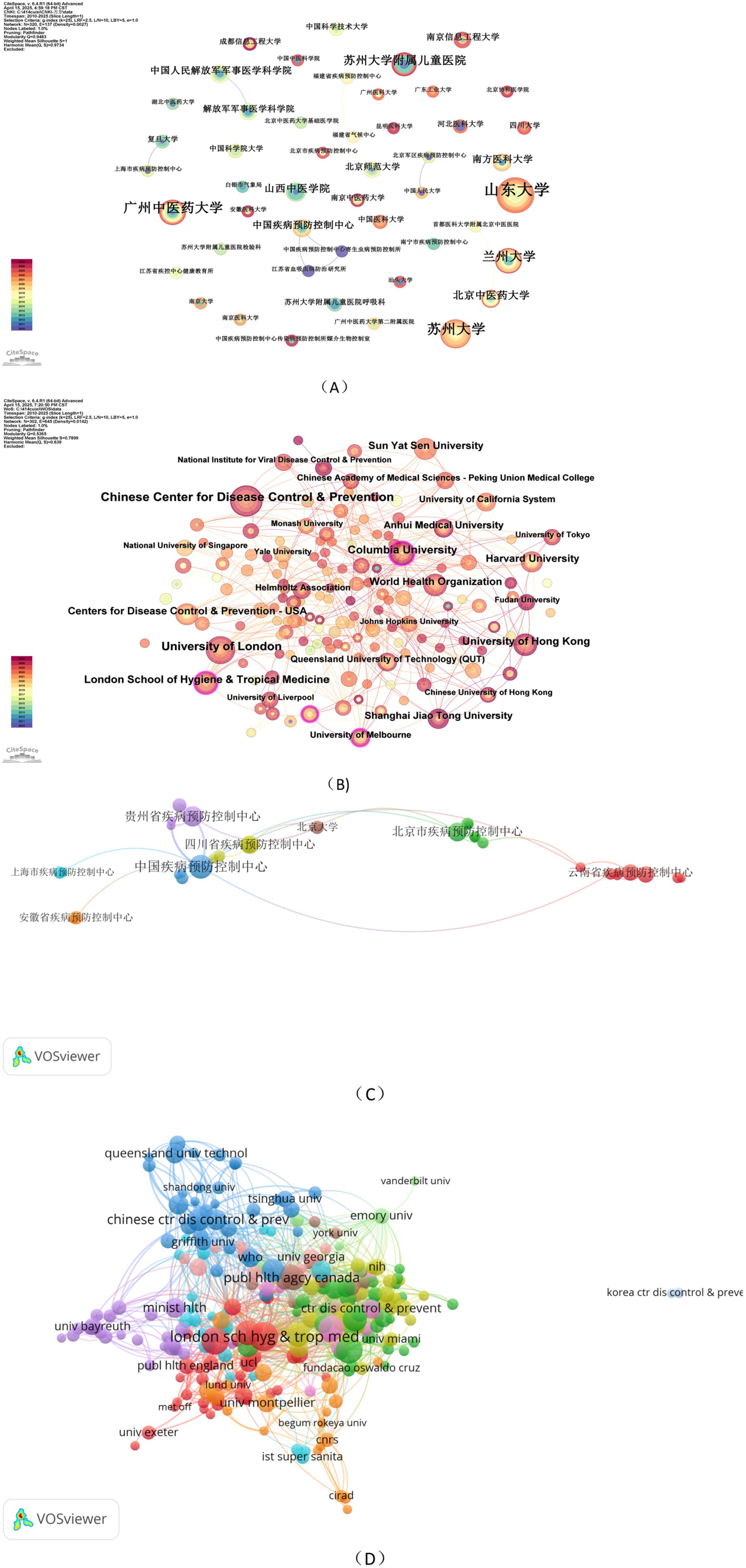
Figure 4. Institutional collaboration networks in Chinese and English literature. (A,B) Networks generated using CiteSpace. (C,D) Networks generated using VOSviewer (minimum frequency≥2). Node size represents the influence of institutions, and connecting lines indicate the strength of collaboration.
Quantitative metrics show that the Chinese network (Figure 4A) (N = 320, E = 137, Density = 0.0027) is less interconnected than its English counterpart (Figure 4B) (N = 302, E = 645, Density = 0.0142). The stark contrast in network density is visually apparent in the sparser layout of Figure 4A compared to the densely interconnected nodes in Figure 4B. In the Chinese literature network (Figure 4C), collaborations are predominantly domestic and centered on the CDC system. This centralized, sector-based collaborative structure is clearly visualized in Figure 4C, where connections radiate from a few core hubs. This reflects a centralized, sector-based collaborative structure, focusing primarily on coordination within China’s national public health infrastructure.
Conversely, the English literature network (Figure 4D) exhibits distinct globalization, involving universities and research institutions across multiple countries. As depicted in Figure 4D, the network demonstrates extensive interdisciplinary and international cooperation, with numerous clusters of nodes forming a complex global web. This network demonstrates extensive interdisciplinary and international cooperation, objectively reflecting its broader collaborative scale and greater cohesion.
This structural divergence fundamentally stems from differences in research scope and data requirements. The Chinese network’s configuration aligns with its focus on localized public health issues. This research relies on stable synergies between the domestic CDC system and key universities (e.g., Shandong University, Lanzhou University), leveraging regional surveillance data and control practices. This “intra-system concentration” model efficiently serves the needs of precise prevention and control for diseases such as hand, foot, and mouth disease and regional respiratory infections at national and local levels.
In contrast, the high connectivity of the English collaboration network corresponds to its focus on addressing global challenges. With hubs such as Harvard University and the London School of Hygiene and Tropical Medicine, and in coordination with international organizations like the WHO, this network aims to integrate cross-regional, multidisciplinary resources to tackle macro-level issues such as the distribution of transnational vector-borne diseases. Despite its density, network nodes remain concentrated in Europe, North America, and Southeast Asia, a geographical distribution pattern that is clearly mapped in Figure 4D, highlighting the persistent imbalance in global scientific resource distribution.
3.3 Core authors
An in-depth analysis of the author collaboration networks in Chinese and English literature reveals two distinct ecosystems of scientific organization. The author network for Chinese literature (Figures 5A,C) exhibits marked characteristics of centralization and continuity. This network (Figure 5A), comprising 393 authors, is formed around stable research teams led by scholars such as Yan Yongdong and Zhou Xiaonong. As shown in Figure 5A, these core authors occupy central positions, with dense connections radiating to their collaborators. These teams typically focus on long-term, dedicated exploration of specific research directions. For instance, Yan Yongdong’s team has consistently investigated the association between childhood respiratory diseases and climatic factors. The persistence of these collaborative clusters over time is reflected in the stable network structure shown in Figure 5C. This research model requires scientists to systematically collect, collate, and analyze regional epidemiological data over extended periods.
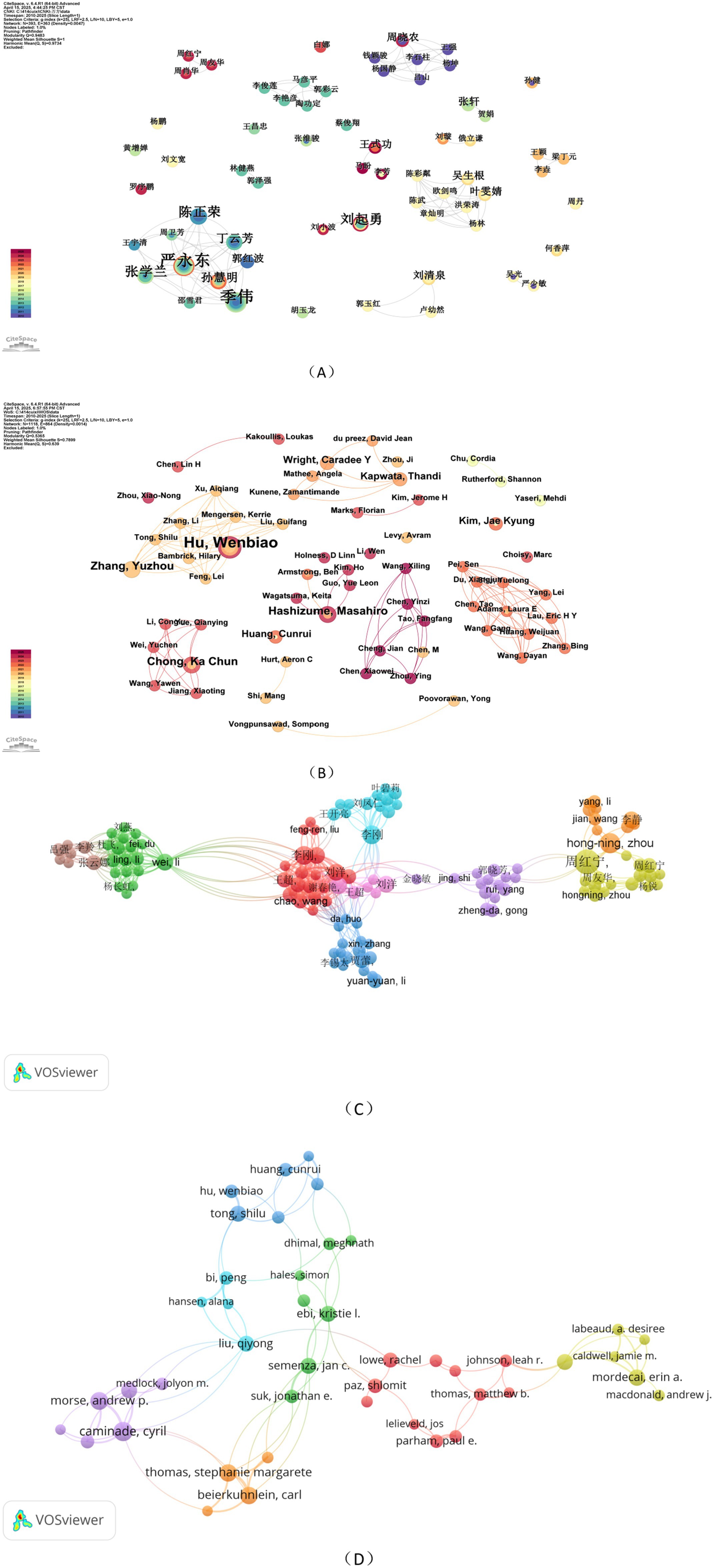
Figure 5. Author collaboration networks mapped with CiteSpace (A,B) and VOSviewer (C,D; frequency C ≥ 2, D ≥ 5). Node size and color represent author influence and institutional/disciplinary affiliation, while line thickness denotes collaboration strength.
This highly structured collaboration model is closely aligned with the practical needs of public health research in China. Research focused on the prevention and control of local infectious diseases, such as hand, foot, and mouth disease, demands continuous access to and analysis of localized disease surveillance data and environmental variables. In this context, stable, long-term research teams led by core scholars are more conducive to ensuring the continuity of research data and the consistency of the analytical framework. Concurrently, as this research primarily relies on established epidemiological methodologies, the need for integrating cross-disciplinary technologies is relatively limited. This fosters a tightly knit, internal team structure centered on domain experts, a pattern clearly demonstrated by the cohesive clusters visible in both Figure 5A,C.
In contrast, the author network for English literature (Figures 5B,D) demonstrates features of distribution and dynamism. This network (Figure 5B), encompassing 1,118 authors, has shown increasingly active collaboration over the past 5 years, forming multiple, relatively independent yet interconnected research clusters. This decentralized structure is visually apparent in Figure 5B, which shows numerous medium-sized clusters distributed across the network rather than a few dominant centers. This loose and open collaborative structure is well-suited to the complex demands of global climate change and health research, where different teams might simultaneously focus on dengue outbreaks in Southeast Asia, influenza transmission patterns in high-latitude countries, or malaria control challenges in Africa.
Such a broadly distributed research landscape necessitates diverse technical expertise. From vector ecology to viral genomics, and from spatial statistics to climate modeling, each specialized area requires corresponding technical proficiency. Consequently, research teams often form flexible collaboration networks comprising personnel from different professional backgrounds, tailored to the needs of specific projects. The diversity of these collaborations is evident in Figure 5D, with varied cluster formations and inter-cluster connections. In recent years, public health crises like the global COVID-19 pandemic and data-sharing initiatives promoted by organizations such as the WHO have further accelerated this interdisciplinary, cross-regional collaborative model, expanding and deepening the field’s collaborative network.
In summary, these two collaboration models reflect the profound connection between the form of scientific organization and the nature of the research topics. The stability and continuity of the Chinese author network are advantageous for conducting systematic and in-depth exploration of specific public health issues. Conversely, the openness and flexibility of the English author network are better suited to addressing complex challenges on a global scale. Each model possesses distinct characteristics, and together they enrich the diversity of the global scientific research system. These contrasting organizational patterns are clearly visualized through the comparative analysis of Figures 5A–D, providing compelling visual evidence for the structural differences described above.
3.4 Source journals
The publication landscape of Chinese and English journals in the field of climate change and infectious diseases (Table 1) reflects systematic differences in their academic communication systems and target audiences. Analysis reveals that Chinese journals constitute a hybrid system balancing academic exchange with public knowledge translation. Within this system, specialized medical journals (20 articles) serve as platforms for disseminating cutting-edge research, while health science popularization journals (26 articles) function as crucial bridges, translating professional knowledge into public health practice. This “dual-track” model exemplifies the distinctive Chinese academic approach of closely integrating scientific research, policy application, and public education.
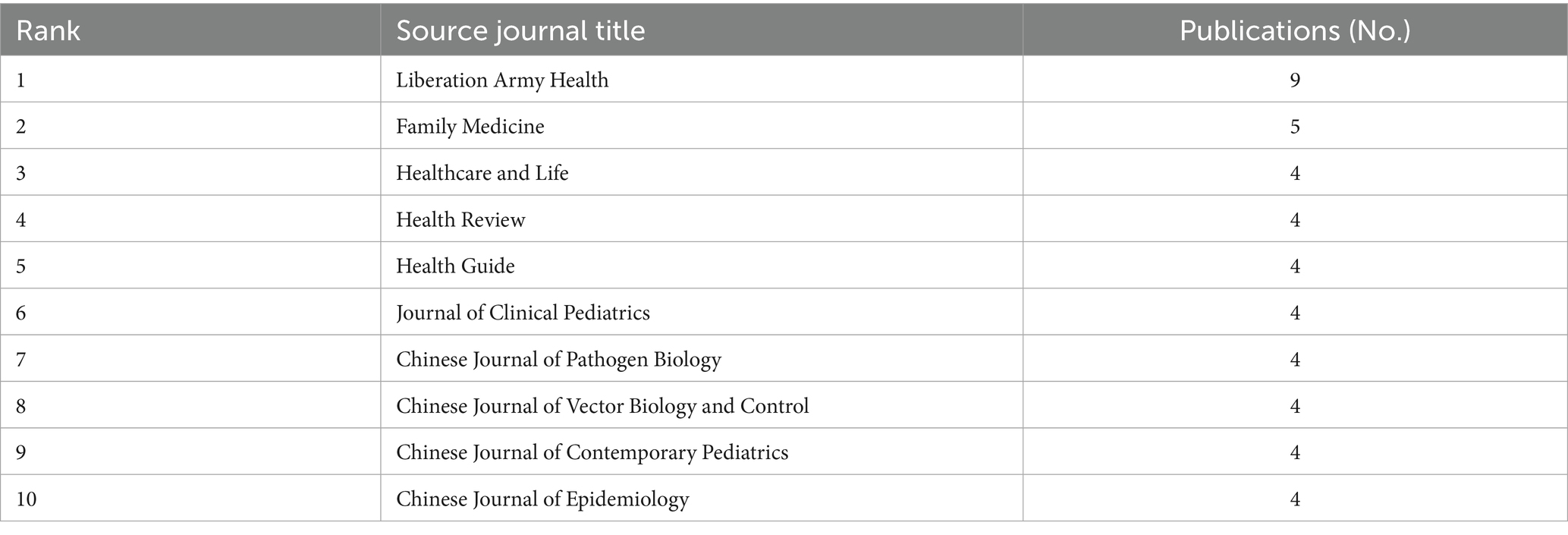
Table 1. Top 10 Chinese journals publishing on climate change and infectious diseases (2010–2025), ranked by publication volume.
In contrast, English journals form a highly internationalized dissemination network with clear professional specialization (Table 2). Their publications are predominantly concentrated in interdisciplinary journals at the environment-public health nexus, such as the International Journal of Environmental Research and Public Health. This focus aligns directly with the highly integrated research paradigm, combining climate models with epidemiological methods, and with the orientation toward the global academic community. Furthermore, leveraging global databases, English journals benefit from broader author and readership bases, which generally results in higher publication volumes per journal than Chinese journals that primarily serve domestic academic circles.
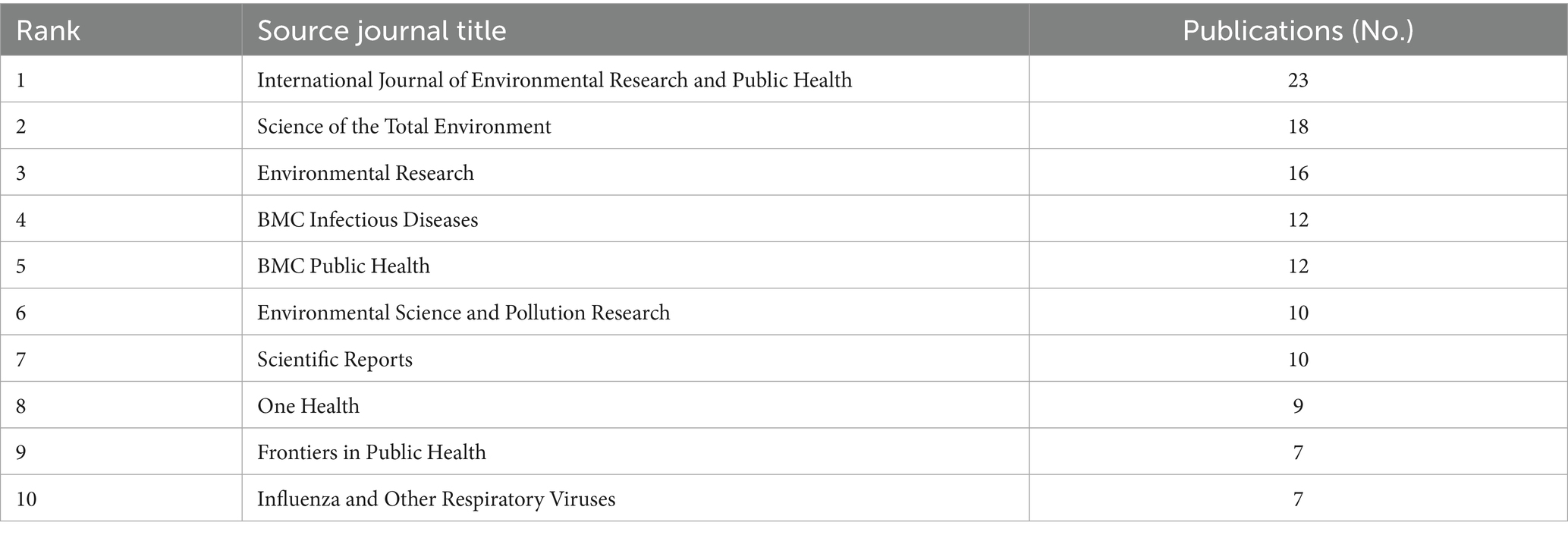
Table 2. Top 10 English journals publishing on climate change and infectious diseases (2010–2025), ranked by publication volume.
This divergence fundamentally represents two academic ecosystems adapting to their respective environments, with neither inherently superior. The “dual-track” system of Chinese journals demonstrates unique efficiency in promoting the social translation and practical application of scientific achievements. Conversely, the international network of English-language journals offers advantages in aggregating global expertise and advancing theoretical paradigm innovation. Moving forward, both systems could learn from each other: Chinese journals could further enhance the international visibility of their specialized sectors, while English journals could consider incorporating effective aspects of the Chinese system’s knowledge dissemination and translation practices to strengthen the societal impact of their research.
3.5 Keywords
3.5.1 Co-occurrence analysis
Keywords are highly condensed representations of the core themes in the literature. Their co-occurrence networks can not only reveal research hotspots in specific fields but also reflect the strength and frequency of associations across different topics. Significant differences exist in the co-occurrence patterns of keywords between Chinese and English literature in the domains of climate change and infectious diseases. These differences are not random but are driven by distinct research traditions disciplinary backgrounds and public health needs (Figure 6)
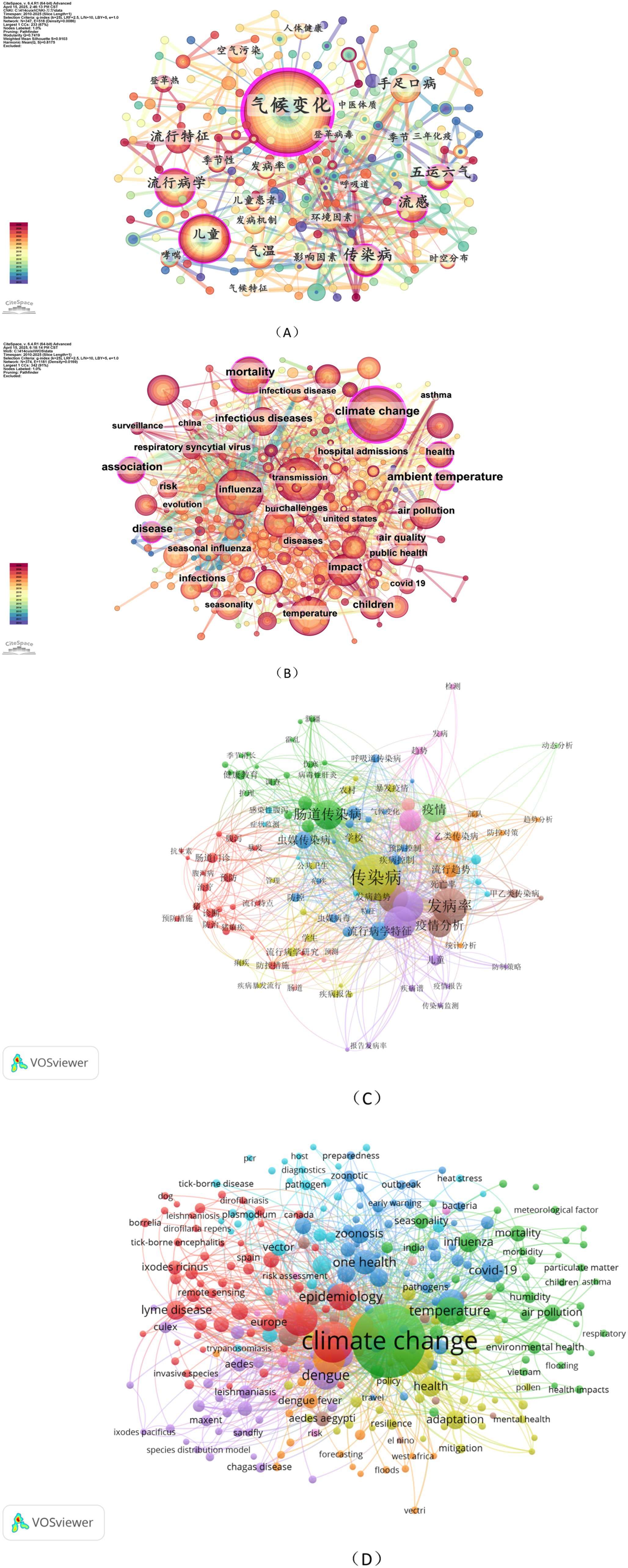
Figure 6. Keyword co-occurrence networks in Chinese and English literature. (A,B) Networks generated using CiteSpace. (C,D) Networks generated using VOSviewer (minimum co-occurrence frequency ≥ 5). Node size and color represent the frequency and category of keywords, respectively. The connecting lines indicate co-occurrence relationships, with line thickness denoting the strength of association.
Core keywords in the Chinese literature include climate change, children, epidemiology, infectious diseases, influenza, and TCM theories. These keywords also function as key nodes with centrality values no lower than 0.10 (Figures 6A,C; Table 3). In English literature, high-frequency keywords with similarly high centrality (≥0.10) are climate, change, mortality, infectious diseases, association, health, environmental temperature, and disease (Figures 6B,D; Table 4).
Although both bodies of literature share common concerns such as infectious diseases and climate change, their overall thematic emphasis differs significantly. The integration of epidemiology with TCM theory in Chinese literature stems fundamentally from China’s robust TCM research foundation and the concurrent need to validate traditional theories using modern epidemiological methods. For instance, exploring the predictive value of TCM theories for climate-sensitive infectious diseases relies on the analytical framework of epidemiology. The prominence of children as a core keyword stems from their developing immune systems, which render them a high-risk group for climate-sensitive infections. Furthermore, with child health being a long-standing priority in China’s public health agenda, research naturally focuses on this vulnerable demographic, establishing children as a critical link connecting climate change to infectious disease dynamics.
Guided by a long-standing tradition of evidence-based medicine, English literature places greater emphasis on quantifiable keywords like mortality, environmental temperature, and association. Mortality is the most accessible and representative quantitative indicator of health outcomes. Environmental temperature is the climatic factor most intrinsically linked to infectious disease transmission (e.g., high temperatures influencing vector reproduction; low temperatures associated with respiratory diseases). Consequently, the analysis of this association forms the core analytical logic in English studies. The high frequency of health originates from the global public health orientation of much English-language research, which necessitates a systematic assessment of the multidimensional health impacts of climatic factors, moving beyond the mechanistic exploration of specific infectious diseases.
3.5.2 Cluster analysis
The keyword clustering map (Figure 7) reflects the main research directions in the field. The rationality and credibility of the clustering results were evaluated using the mean silhouette (S) and modularity (Q) values. The Chinese literature formed 10 clusters (Figure 7A), while the English literature formed 11 clusters (Figure 7B). The Chinese dataset had an S-value of 0.7419 and a Q-value of 0.9103; the English dataset had an S-value of 0.5365 and a Q-value of 0.7899. A modularity value (Q) > 0.3 indicates significant cluster structure, and a mean silhouette value (S) > 0.5 suggests good consistency within clusters.
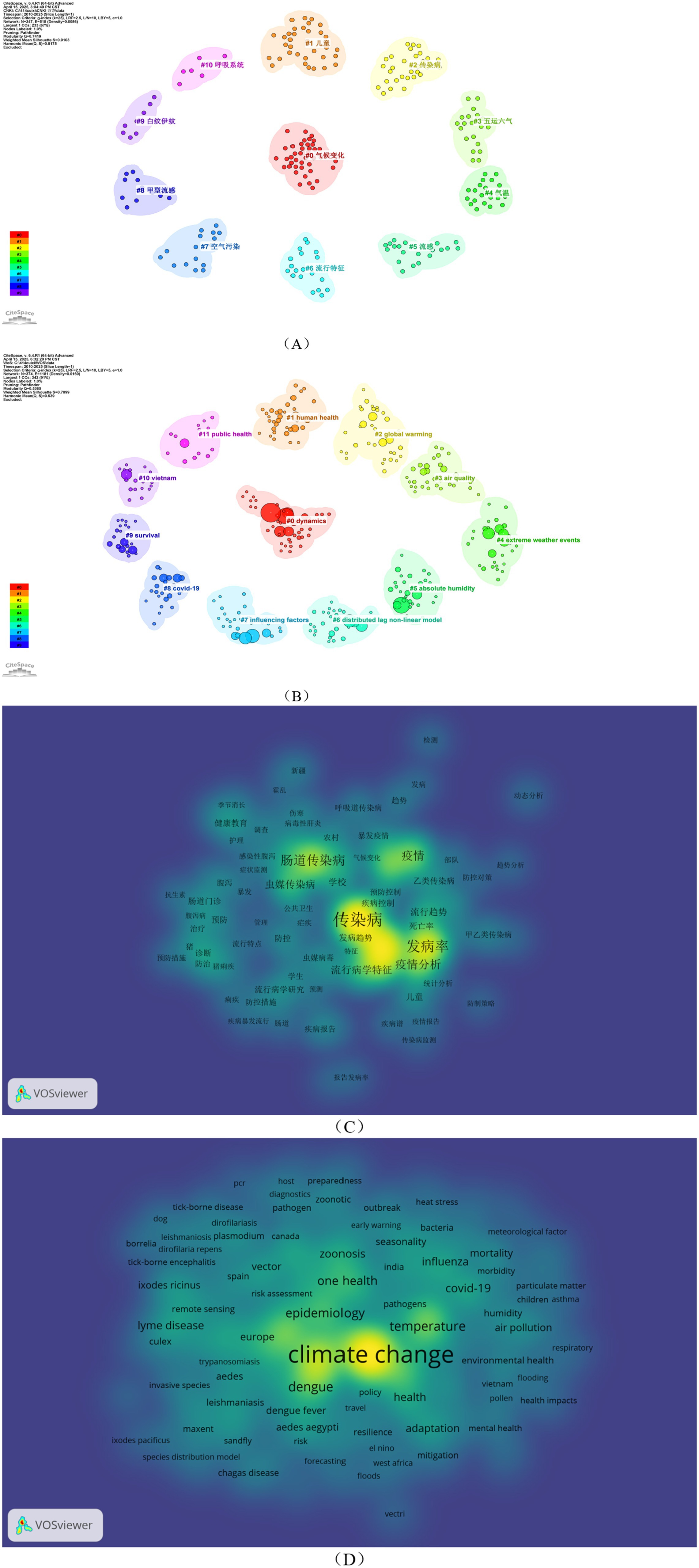
Figure 7. Keyword cluster and density visualizations in Chinese and English literature. (A,B) Cluster maps generated using CiteSpace, illustrating the distribution and grouping of keywords. (C,D) Density visualizations generated using VOSviewer (minimum frequency ≥ 5), highlighting the concentration and distribution patterns of keywords.
Systematic differences are evident between Chinese and English literature in climate change and infectious disease research (Tables 5, 6), reflecting distinct academic traditions and research orientations.
Chinese literature has established a multidimensional research framework encompassing three core directions: integrating and innovating theoretical frameworks, developing protection strategies for vulnerable populations, and analyzing environmental drivers. The formation of this structure is influenced by both indigenous academic traditions and public health needs. Traditional medical theories are being validated and developed using modern epidemiological methods, yielding unique models of disease etiology. The prominent focus on child health research reflects both the biological vulnerability of this population and the sustained attention from the public health system toward key demographic groups. Meanwhile, the in-depth exploration of environmental drivers stems from practical needs to address regional environmental challenges, providing scientific evidence for the development of targeted prevention and control strategies.
English literature demonstrates characteristics of globally oriented and methodology-driven research. Its research agenda primarily includes the mechanisms of pathogen evolution in emerging infectious diseases, health risk assessments of extreme climate events, quantitative analyses of multiple environmental exposures, and systematic studies within the “One Health” framework. The establishment of this paradigm benefits from the combined impetus of technological advancement and global governance needs: molecular biology methods provide tools for pathogen evolution research, frequent extreme climate events generate demand for risk assessment, advances in exposure science support the comprehensive analysis of complex environmental factors, and disciplinary integration promotes the formation of holistic research frameworks.
These two research paradigms hold significant complementary value. Chinese literature provides empirically rich studies with regional characteristics and theoretical innovations through its focused investigations in specific domains. English literature establishes widely applicable assessment frameworks through standardized methodologies and a global perspective. Notably, the contributions of Chinese literature extend beyond traditional theoretical domains, with its innovations in modern epidemiological methods and environmental health risk assessment being equally significant. This diverse research landscape collectively promotes the refinement and development of the global knowledge system in climate change and health.
3.5.3 Keyword landscape and the strongest citation bursts analysis
The cluster landscape view (Figures 8A,B) clearly shows the emergence time and duration of each cluster, structurally revealing the field’s developmental trajectory across different stages. Concurrently, the strongest citation bursts display (Figures 8C,D) provides chronological evidence through the dynamic rise and fall of specific keywords. A comparative analysis of these visualizations demonstrates that Chinese and English literature have followed distinctly different, yet complementary, developmental paths in climate change and infectious disease research. Collectively, these figures reveal that their respective trajectories are deeply rooted in unique problem consciousness and societal needs.

Figure 8. Landscape and burst analysis of keywords and institutions. (A,B) Keyword co-occurrence landscape (CiteSpace), (C,D) Citation bursts for institutions.
Chinese research demonstrates a comprehensive pathway from consolidating a scientific foundation to addressing complex real-world challenges. Its keyword co-occurrence landscape (Figure 8A) exhibits a distinct characteristic of theoretical and methodological integration. For instance, the formation of the unique framework “Seasonal Rhythm - Symptom Pattern - Prevention Strategy” (Cluster #3) integrates traditional wisdom, offering a complementary perspective on understanding the climate-health relationship. Furthermore, the emergent keyword analysis in Figure 8C delineates its specific evolution: the early focus (2010–2013) on basic mechanisms such as “disease transmission” and “immunity” laid the scientific groundwork for subsequent research. Post-2014, the research evolved along a dual track of methodological innovation and thematic diversification. On the one hand, the construction of “prediction models” enhanced early warning capabilities for key diseases like hand, foot, and mouth disease. On the other hand, explorations into traditional concepts such as the “triple transformation” reflected attempts at theoretical pluralism. After 2019, the research agenda further diversified. The unprecedented focus on “air pollution” indicated a proactive response to local environmental health issues. Concurrently, the surge in studies on “epidemiological characteristics” following the COVID-19 pandemic propelled simultaneous advancements in surveillance systems and methodological approaches.
In contrast, the evolution of English-language research reflects the self-renewal of research paradigms under a global perspective and the continuous refinement of quantitative methodologies, a trend visually corroborated by its keyword cluster structure (Figure 8B). This methodological system underwent clear progression, as shown in Figure 8B, evolving from the widely adopted Distributed Lag Non-Linear Models (DLNMs) (Cluster #6) in earlier stages to the subsequent incorporation of causal inference methods such as survival analysis (Cluster #9), forming a clear methodological chain. The emergent keyword timeline in Figure 8D further details this process: the conceptual expansion of “health” during 2015–2017 marked a shift from a single-disease focus toward assessing systemic health impacts. From 2018 to 2020, research entered a phase of deeper quantitative assessment, with “seasonality” and “mortality” becoming core indicators for evaluating the climate-health burden. During the pandemic (2020–2022), the link between “extreme weather” and “respiratory viruses” became a focal point, reflecting a forward-looking concern about compound health threats. In the current phase, the prominence of “meteorological factors” and “exposure assessment” indicates the field’s drive to construct a more universal risk analysis framework through methodological refinement.
Therefore, the integrated analysis of Figures 8A–D demonstrates that the distinction between the two research pathways is not a simple methodological gap, but rather a product of their respective academic traditions and public health priorities. English-language research supports global risk assessment through methodological standardization and paradigm renewal, while Chinese research, through the integration of foundational consolidation, methodological innovation, and theoretical pluralism, provides more contextually grounded solutions for regionally complex problems.
3.5.4 Cluster timeline analysis
Analysis of the cluster timelines reveals a multi-dimensional and interdisciplinary development trend in the research on climate change and infectious diseases. The evolution of research themes exhibits three prominent characteristics (Figure 9). Sustained Deepening of Foundational Themes: Core topics such as children’s health (Cluster #1) and respiratory diseases (Cluster #10) have been consistently studied, forming stable research frameworks. In particular, research on the impact of temperature (Cluster #4) on infectious diseases has evolved from early descriptive statistics to machine learning-based prediction methods.
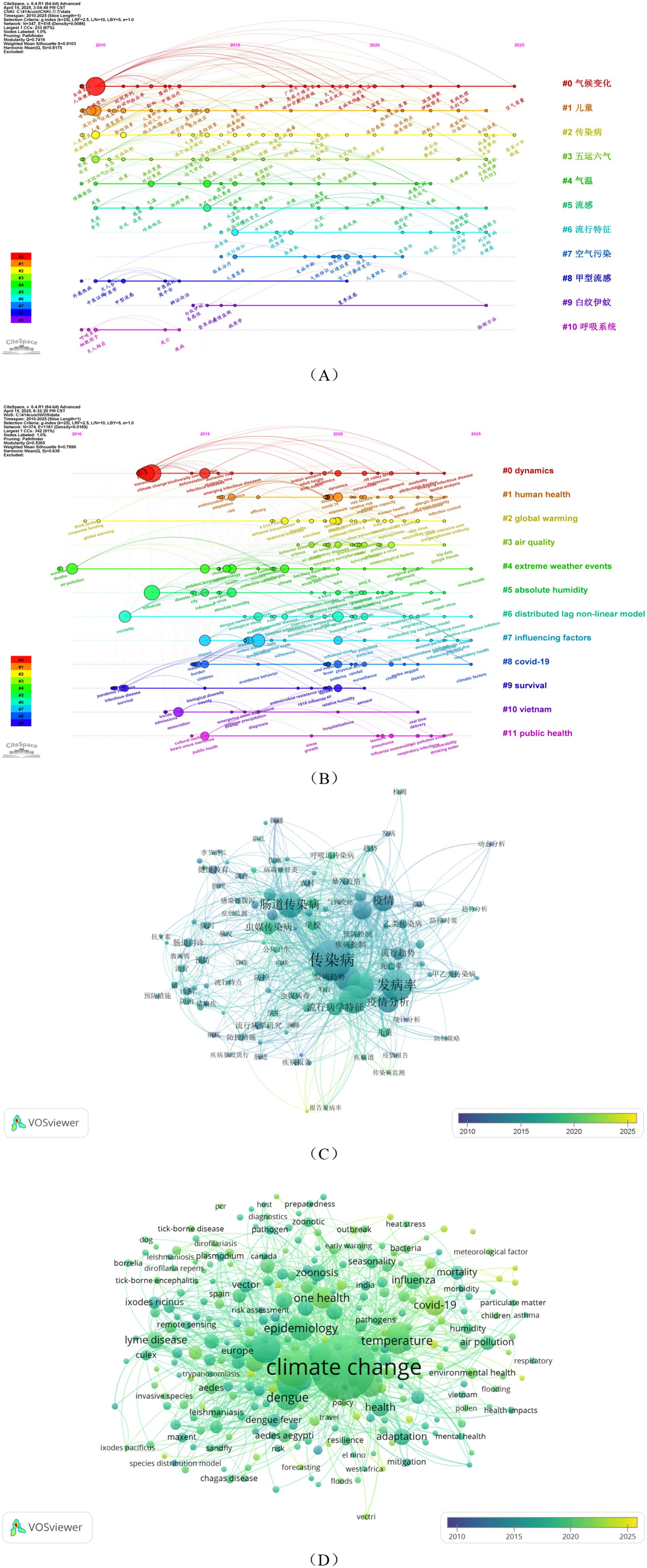
Figure 9. Landscape and burst analysis of keywords and institutions. (A,B) Chronological clusters generated by Ci eSpace, showing the distribution and evolution of keywords in Chinese and English literature, respectively. (C,D) Temporal clusters generated by VOSviewer, presenting keyword grouping and changes over time.
Analysis of cluster timelines reveals that research on climate change and infectious diseases has evolved along multidimensional, interdisciplinary trajectories, primarily characterized by the expansion of theoretical frameworks, the refinement of research precision, and the synergistic integration of methodologies with regional practices. As clearly demonstrated in Figure 9—comprising Figure 9A (timeline view of keyword clusters from Chinese literature) and Figure 9B (timeline view of keyword clusters from English literature) generated via CiteSpace—the distribution and evolution of keywords in both corpora provide visual evidence of the field’s developmental trajectory.
On a theoretical level, Chinese research demonstrates a distinct capacity to bridge traditional wisdom with modern scientific inquiry. A pertinent example is the integration of the TCM disease mechanism theory of “cold-dampness pestilence” with influenza research during the pandemic. This represents not merely a direct application of traditional theory but a process of empirical validation and creative transformation of its scientific connotations within a modern medical context, offering a complementary theoretical perspective for understanding climate-health relationships. This theoretical exploration finds its echo in the timeline of Chinese keyword clusters (Figure 9A), where the evolving clusters related to traditional medicine and modern infectious disease research visually trace this trajectory of theoretical integration.
Concurrently, the research paradigm is undergoing a significant shift from merely associating phenomena to dissecting underlying mechanisms, a trend markedly evident in both Chinese and English literature. For instance, research on Aedes albopictus has progressed from establishing macro-level correlations between temperature and dengue incidence to precisely quantifying the impact of temperature on key biological processes, such as the extrinsic incubation period of the virus. This shared focus on mechanism signifies the field’s concerted effort to build more predictive risk models. The emergence and evolution of keywords like “mechanism analysis” and “biological processes” in the cluster timelines (Figures 9A,B) similarly reflect this shared paradigmatic shift.
In methodological advancement, English literature continues to lead in developing and applying cutting-edge statistical methods, such as causal inference, while Chinese literature exhibits strong integrative capabilities in adapting methodologies to local contexts and addressing regionally complex issues. For example, Chinese studies effectively combine multi-source data with diverse modelling approaches to investigate the intricate “air pollution-climate factor-health outcome” chain. Meanwhile, the rise of case studies from Southeast Asia indicates that empirical data from diverse regions are continually testing and enriching the universality of global models. These methodological trends are also clearly visible in the evolving keyword clusters related to “causal inference” and “multi-source data integration” in Figures 9A,B.
4 Discussion
This study employs a bibliometric approach utilizing CiteSpace and VOSviewer to systematically elucidate the dynamic evolution of the research field concerning climate change and associated infectious diseases from 2010 to 2025. The overall volume of relevant research demonstrates a growing trend, with increasing emphasis on studies investigating the development trajectories of infectious diseases. The field is transitioning from singular-disease analysis to complex-system assessment.
Research themes show differentiated development across three categories of infectious diseases. Post-2018, research on vector-borne diseases, such as dengue fever, increased significantly, closely linked to the spread of vector organisms driven by climate warming (Abbasi, 2025; de Souza and Weaver, 2024). Furthermore, factors including enhanced human mobility, land-use change, and extreme weather events have substantially contributed to the rise of arboviral diseases such as dengue. This disease has evolved from a regional health concern into a paradigmatic example of the health impacts of climate change. Specifically, increased human mobility (Lowe and Codeço, 2024), through cross-regional population movement, global trade, and tourism—has accelerated the geographical spread of viruses and vector organisms (Ferraguti et al., 2023). Land-use changes (Dong et al., 2024), such as urban expansion and agricultural land modification, have altered vector habitats and breeding environments, directly affecting their population dynamics. Extreme weather events like heavy rainfall and flooding can create numerous stagnant water bodies in the short term, providing concentrated breeding grounds for mosquitoes and other vectors, thereby further elevating transmission risk. It is this strong association with global issues that has drawn dengue research attention and resources beyond its traditional endemic areas, rendering it a “symbolic” disease.
In stark contrast, research on respiratory infectious diseases has consistently maintained a dominant global position. This prominence stems from their potential to rapidly escalate into global pandemics via modern transportation networks, posing immediate, non-selective threats to economic and social stability across nations. This triggers the most rapid and extensive mobilization of scientific resources, culminating in a peak in research output, particularly during the COVID-19 pandemic (Vollset et al., 2024; Dayuan et al., 2022).
Within the current global landscape of infectious disease research, enteric infectious diseases like cholera have long occupied a relatively marginalized position. This status does not stem from its perceived lower severity but rather from the prevalent international perception of cholera as a technically solvable problem associated with developmental challenges in low- and middle-income regions. The value of cholera research lies primarily in applied fields such as water safety, basic sanitation, and humanitarian response. Its academic influence is constrained by the global system of scientific resource allocation. This imbalance in the research landscape reflects a structural asymmetry within global health knowledge production: diseases with high cross-border transmission potential (Zou et al., 2024) often receive prioritized attention, while health challenges linked to regional poverty struggle to reach the core of the international research agenda.
In the methodological evolution of contemporary infectious disease research, the global academic community demonstrates a clear trajectory: shifting from macro-level description to micro-level analysis, and from linear prediction to simulation-based forecasting. Early studies (Brownstein et al., 2023) primarily relied on traditional statistical tools such as time-series analysis and grey models. As the discipline advanced, significant breakthroughs have been achieved along two key dimensions.
On the one hand, a complex modeling paradigm based on multi-source data fusion has matured. The international academic community has shown particular strength in this area: the introduction of advanced statistical methods, including mixed-effects models and Bayesian spatial hierarchical models, has significantly enhanced the precision of environmental exposure assessment. Furthermore, by coupling climate system models with disease transmission dynamics models and integrating geospatial data from remote sensing, researchers have successfully constructed a multidimensional analytical framework encompassing climate, environment, hosts, and pathogens. In recent years, machine learning algorithms such as Random Forest and Long Short-Term Memory (LSTM) networks, leveraging their unique advantages in handling non-linear relationships and capturing the impacts of extreme events, have emerged as the cutting-edge direction in predictive modeling (Wang et al., 2020).
On the other hand, Chinese researchers have demonstrated a distinct pathway for methodological innovation. Their contributions are evident not only in developing localized research paradigms that integrate spatiotemporal theories from traditional medicine with modern statistical techniques to explore climate-disease associations but also in actively promoting the deep application of modern computational methods in public health practice (Kong et al., 2023; Panteli et al., 2025). This is notably exemplified by the effective use of models such as Artificial Neural Networks and Gradient Boosting Machines to integrate multi-source data—including meteorological monitoring data, web behavior indices, and population mobility information—to construct intelligent analytical frameworks for forecasting the risks of both seasonal and imported infectious diseases. For instance, the development of deep learning-based multi-factor models utilizing data on scarlet fever and mumps from Jiangsu Province has substantially improved the prediction accuracy for seasonal diseases.
In summary, the methodological development in this field presents a landscape characterized by simultaneous global synergy and regional distinctiveness. While the international academic community continues to lead innovation in constructing complex models, Chinese academia has cultivated unique strengths in data-driven disease surveillance and control, as well as the practical application of artificial intelligence technologies. Together, these complementary efforts are advancing and transforming global infectious disease research methodologies.
Thematic analysis reveals distinct research paradigms in English and Chinese literature for addressing the relationship between “pollution-climate change-respiratory diseases” and “respiratory diseases.”
English-language research demonstrates a global-scale approach through two interconnected domains: exposure science and meteorological medicine (Rodríguez et al., 2024; Sung and Hopper, 2023; Yang et al., 2023; Topaloglu et al., 2023; Liang et al., 2023; Nguyen et al., 2024). In exposure science, studies develop integrated spatiotemporal models that combine satellite and ground-based monitoring data to quantify meteorological influences on pollutant behavior. These models, enhanced by mixed-effects and Bayesian hierarchical frameworks, enable causal inference of environmental triggers for respiratory conditions, including asthma exacerbations, COPD progression, and childhood respiratory infections (Zhang et al., 2022).
Concurrently, meteorological medicine research utilizes global surveillance networks to analyze lagged health effects of extreme climate events. For instance, one study documented a significant increase in elderly pneumonia hospitalizations within 72 h of the heatwave (Cao et al., 2025). Such findings support the development of dynamic early-warning systems for transnational public health responses (Wei et al., 2025).
Chinese research exhibits a strong regional focus, addressing location-specific environmental challenges through several key directions. Studies have established refined exposure assessment frameworks that account for China’s diverse climatic conditions, ranging from the northern temperate to the southern subtropical zones (National Disease Control and Prevention Administration, 2024; Linares et al., 2020; Wu et al., 2021; Liu et al., 2023). In the north, research has elucidated how winter coal combustion interacts with meteorological conditions to elevate respiratory disease incidence, while southern studies examine the synergistic effects of high humidity and ozone pollution.
Chinese scholars have also made substantial progress in developing operational early-warning systems. By integrating multi-source environmental and health data, they have established evidence-based intervention thresholds, such as activating public health alerts when PM2.5 concentrations exceed 75 μg/m3 and temperatures exceed 30 °C. These practical frameworks demonstrate how scientific findings can be directly translated into public health actions.
Both research traditions acknowledge the transboundary nature of these health challenges. English literature documents Saharan dust impacts on European respiratory health (Singh et al., 2024), while Chinese studies examine East Asian monsoon-driven PM₂.₅ effects. Mechanistic research indicates that extreme climate events and air pollution compound risks by altering pollutant dispersion and compromising respiratory mucosal defenses (Aghapour et al., 2022). This shared understanding is fostering increased standardization of risk assessment metrics and cross-regional collaboration, laying the foundation for globally coordinated respiratory health protection strategies.
Notably, while Chinese and English-language research are paradigmatically complementary and jointly advance cross-regional collaboration, their research institutions’ collaborative network structures differ significantly, directly impacting collaboration efficiency. Chinese research institutions show marked fragmentation: their inter-institutional collaboration network density is only 0.0027, far lower than the 0.0142 in the English-language community. This gap means sparse connections and a weak collaborative foundation among Chinese institutions, potentially hindering knowledge flow and integration. Most collaborations remain within individual institutions; this closedness limits interdisciplinary innovation and tends to homogenize research perspectives. In contrast, the higher network density in the English-language community enables more frequent institutional exchanges, fostering diverse perspectives and comprehensive solutions. This suggests optimizing China’s institutional collaboration ecosystem is essential to unlock its strengths in localized early warning and regional pollution-health research, laying a solid foundation for cross-regional and interdisciplinary collaboration. This difference may stem from multiple factors, including institutional policies, cultural contexts, and research funding systems.
5 Limitations
The four databases underpinning our literature search strategy—PubMed, Web of Science, Wanfang, and China National Knowledge Infrastructure (CNKI)—exhibit significant heterogeneity in their coverage and source materials. The selection criteria of international databases such as PubMed and Web of Science are heavily skewed toward English-language peer-reviewed journals. This may systematically exclude research findings published in other languages (e.g., Chinese) that contain important regional or local knowledge. Conversely, CNKI and Wanfang, as core resources covering Chinese academic literature, provided this study with crucial regional evidence. However, the limited overlap in coverage between these databases and the international databases poses inherent challenges for integrating global and regional evidence. This disparity in literature coverage, inherent to the database architectures themselves, is a potential source of language and publication bias.
Furthermore, the aforementioned bias subsequently affects the representativeness of specific disease systems within our study. The inclusion focus of major international indexes tends to prioritize diseases with a substantial global health burden. Consequently, diseases with a distinct regional distribution or those primarily affecting marginalized populations—such as certain neglected tropical diseases, specific zoonoses, and fungal infections—often have lower visibility within the global academic publishing system. While regional resources like CNKI provide vital supplementary research on these conditions, the segregation across different database systems makes it difficult to construct an unbiased, comprehensive global evidence map.
6 Conclusion
In summary, future research should focus on three things. First, set up a shared research framework that looks at the combined effects of climate change on many infectious diseases. Policymakers and public health teams can create cross-sector ways to work together and share data from the CDC, meteorological services, and environmental agencies. This can support a joint system for surveillance and early warning. For example, a national climate-and-health data platform could publish regular cross-disease risk reports to guide public health decisions.
Second, link environmental science, data science, and medicine more closely to build AI-driven prediction models. Public health agencies can fund interdisciplinary projects so universities, research institutes, and tech companies can develop tools for climate-sensitive diseases.
Finally, build a global research network and a standard data-sharing platform, with extra focus on climate-vulnerable regions. Policymakers can support an international climate-and-health consortium that sets common data standards and shared protocols. For example, the World Health Organization and the World Meteorological Organization can provide technical help and funding to developing countries to improve disease surveillance. At the same time, encourage multinational projects on disease burden in high-risk regions to support knowledge sharing and technology transfer.
These steps can deepen academic understanding of how climate change and infectious diseases are linked, and they can give policymakers and public health teams more practical ways to act, so they can respond better to the health risks of global climate change.
Data availability statement
The original contributions presented in the study are included in the article/supplementary material, further inquiries can be directed to the corresponding author.
Author contributions
TZ: Writing – original draft. JL: Writing – review & editing.
Funding
The author(s) declare that financial support was received for the research and/or publication of this article. This research was supported in part by the Hunan Provincial Natural Science Foundation of China under Grant 2024JJ8359, the Hunan Provincial Department of Education Scientific Research under Grant 22B0376 and 24A0285, the Hunan Province Traditional Chinese Medicine Scientific Research Project under Grant A2024003, the 2022 Doctoral Research Initiation Fund of Hunan University of Chinese Medicine under Grant 0001036.
Conflict of interest
The authors declare that the research was conducted in the absence of any commercial or financial relationships that could be construed as a potential conflict of interest.
Generative AI statement
The authors declare that no Gen AI was used in the creation of this manuscript.
Any alternative text (alt text) provided alongside figures in this article has been generated by Frontiers with the support of artificial intelligence and reasonable efforts have been made to ensure accuracy, including review by the authors wherever possible. If you identify any issues, please contact us.
Publisher’s note
All claims expressed in this article are solely those of the authors and do not necessarily represent those of their affiliated organizations, or those of the publisher, the editors and the reviewers. Any product that may be evaluated in this article, or claim that may be made by its manufacturer, is not guaranteed or endorsed by the publisher.
Supplementary material
The Supplementary material for this article can be found online at: https://www.frontiersin.org/articles/10.3389/fclim.2025.1703904/full#supplementary-material
Abbreviations
TCM, Traditional Chinese Medicine; CDC, Chinese Center for Disease Control and Prevention.
References
Abbasi, E. (2025). The impact of climate change on travel-related vector-borne diseases: a case study on dengue virus transmission. Travel Med. Infect. Dis. 65:102841. doi: 10.1016/j.tmaid.2025.102841
Aghapour, M., Ubags, N. D., Bruder, D., Hiemstra, P. S., Sidhaye, V., Rezaee, F., et al. (2022). Role of air pollutants in airway epithelial barrier dysfunction in asthma and COPD. Eur Respir Rev. 31:210112. doi: 10.1183/16000617.0112-2021
Anikeeva, O., Hansen, A., Varghese, B., Borg, M., Zhang, Y., Xiang, J., et al. (2024). The impact of increasing temperatures due to climate change on infectious diseases. BMJ 387:387. doi: 10.1136/bmj-2024-079343
Baker, R. E., Mahmud, A. S., Miller, I. F., Rajeev, M., Rasambainarivo, F., Rice, B. L., et al. (2022). Infectious disease in an era of global change. Nat. Rev. Microbiol. 20, 193–205. doi: 10.1038/s41579-021-00639-z
Brownstein, J. S., Rader, B., Astley, C. M., and Tian, H. (2023). Advances in artificial intelligence for infectious-disease surveillance. N. Engl. J. Med. 388, 1597–1607. doi: 10.1056/NEJMra2119215
Cao, X. X., Zhu, W. H., Luo, Z., He, R., Li, Y., Hui, S., et al. (2025). The association between weekly mean temperature and the epidemic of influenza across 122 countries/regions, 2014–2019[J]. J. Biomed. Res. doi: 10.7555/JBR.39.20250010
Chen, J., Deng, S., Xu, X., Chen, S., Abo, Y. N., Bassat, Q., et al. (2025). Regional and type-specific variations in the global seasonality of human parainfluenza viruses and the influence of climatic factors: a systematic review and meta-analysis. Lancet Glob. Health 13, e1425–e1435. doi: 10.1016/S2214-109X(25)00188-3
Dayuan, Z., Lan, L., Luhua, X., Huanjie, L., Dahao, C., Yumiao, L., et al. (2022). A bibliometric analysis of research related Chinese medicine in the prevention and treatment of corona virus disease 2019. Heliyon 8:e11120. doi: 10.1016/j.heliyon.2022.e11120
de Souza, W. M., and Weaver, S. C. (2024). Effects of climate change and human activities on vector-borne diseases. Nat. Rev. Microbiol. 22, 476–491. doi: 10.1038/s41579-024-01026-0
Dong, Y., Liang, C. J., Chen, Y., and Hua, J. (2024). A visual modeling method for spatiotemporal and multidimensional features in epidemiological analysis: applied covid-19 aggregated datasets. Comput. Vis. Media 10, 161–186. doi: 10.1007/s41095-023-0353-5
Downs, J., Downs, J., Mesev, V., and Chakraborty, S. (2025). Climate-induced expansion of Lyme disease in east Central Ohio. Int. J. Environ. Health Res. 35, 2717–2727. doi: 10.1080/09603123.2025.2456966
Ferraguti, M., Magallanes, S., Suarez-Rubio, M., Bates, P. J. J., Marzal, A., and Renner, S. C. (2023). Does land-use and land cover affect vector-borne diseases? A systematic review and meta-analysis. Landsc. Ecol. 38, 2433–2451. doi: 10.1007/s10980-023-01746-3
Kong, L. H., Tao, G. S., Lu, S., Gu, Z. S., Ke, Z. N., Shen, Y., et al. (2023). Analysis of the incidence pattern of 30,262 influenza cases in Wuxi area based on the theory of five movements and six qi[J]. China Journal of Traditional Chinese Medicine and Pharmacy, 38, 2811–2815. Available online at: http://m.qikan.cqvip.com/Article/ArticleDetail?id=7110058652
Lepore, L., Vanlerberghe, V., Verdonck, K., Metelo, E., Diallo, M., and Van Bortel, W. (2025). Vector control for aedes aegypti and aedes albopictus mosquitoes implemented in the field in sub-saharan africa: A scoping review. PLOS Neglected Tropical Diseases. 19:e0013203. doi: 10.1371/journal.pntd.0013203
Liang, Y., Sun, Z., Hua, W., Li, D., Han, L., Liu, J., et al. (2023). Spatiotemporal effects of meteorological conditions on global influenza peaks. Environ. Res. 231:116171. doi: 10.1016/j.envres.2023.116171
Linares, C., Martinez, G. S., Kendrovski, V., and Diaz, J. (2020). A new integrative perspective on early warning systems for health in the context of climate change. Environ. Res. 187:109623. doi: 10.1016/j.envres.2020.109623
Liu, J. S., Li, X. C., Zhang, Q. Y., Han, L. F., Xia, S., Kassegne, K., et al. (2023). China’s application of the one health approach in addressing public health threats at the human-animal-environment interface: advances and challenges. One Health 17:100607. doi: 10.1016/j.onehlt.2023.100607
Lowe, R., and Codeço, C. T. (2024). Harmonizing multisource data to inform vector-borne disease risk management strategies. Annu. Rev. Entomol. 70. doi: 10.1146/annurev-ento-040124-015101
Muralinath, E., Satyanarayana Manjari, P., Pragna, D., Latha, C. R. S., Sridevi, K., and Balaji, D. G. S.. A requisite parameters of noro virus include etiology, epidemiology, patho physiology, diagnosis, differential diagnosis, treatment, prognosis, complications and consultations. Patho Physiology, Diagnosis, Differential Diagnosis, treatment, prognosis, complications and consultations. Cham: Springer.
National Disease Control and Prevention Administration. (2024). National climate change health adaptation action plan (2024-2030). [Policy document ]. Available online at: http://www.ndcpa.gov.cn/jbkzzx/c100081/common/content/content_1836297186892951552.html
Nguyen, T. T. N., Vu, T. D., Vuong, N. L., Pham, T. V. L., le, T. H., Tran, M. D., et al. (2024). Effect of ambient air pollution on hospital admission for respiratory diseases in Hanoi children during 2007–2019. Environ. Res. 241:117633. doi: 10.1016/j.envres.2023.117633
Panteli, D., Adib, K., Buttigieg, S., Goiana-da-Silva, F., Ladewig, K., Azzopardi-Muscat, N., et al. (2025). Artificial intelligence in public health: promises, challenges, and an agenda for policy makers and public health institutions. Lancet Public Health 10, e428–e432. doi: 10.1016/S2468-2667(25)00036-2
Pfenning-Butterworth, A., Buckley, L. B., Drake, J. M., Farner, J. E., Farrell, M. J., Gehman, A. L. M., et al. (2024). Interconnecting global threats: climate change, biodiversity loss, and infectious diseases. The Lancet Planetary Health 8, e270–e283. doi: 10.1016/S2542-5196(24)00021-4
Phillips, M. C., LaRocque, R. C., and Thompson, G. R. (2024). Infectious diseases in a changing climate. JAMA 331, 1318–1319. doi: 10.1001/jama.2023.27724
Phung, D., Colón-González, F. J., Weinberger, D. M., Bui, V., Nghiem, S., Chu, C., et al. (2025). Advancing adoptability and sustainability of digital prediction tools for climate-sensitive infectious disease prevention and control. Nat. Commun. 16:1644. doi: 10.1038/s41467-025-56826-6
Quintero-Campos, P., Salvador-Clavell, R., Martín, B., Fouz, B., Amaro, C., Tortajada-Genaro, L. A., et al. (2025). Environmental monitoring of a climate change indicator (Vibrio vulnificus) in coastal wetland water samples based on field-deployable detection. Sci. Total Environ. 986:179791. doi: 10.1016/j.scitotenv.2025.179791
Rodríguez, A., Kamarthi, H., Agarwal, P., Ho, J., Patel, M., Sapre, S., et al. (2024). Machine learning for data-centric epidemic forecasting. Nat. Mach. Intell. 6, 1122–1131. doi: 10.1038/s42256-024-00895-7
Semenza, J. C., Rocklöv, J., and Ebi, K. L. (2022). Climate change and cascading risks from infectious disease. Infect. Dis. Ther. 11, 1371–1390. doi: 10.1007/s40121-022-00647-3
Singh, S., Sharma, P., Pal, N., Sarma, D. K., Tiwari, R., and Kumar, M. (2024). Holistic one health surveillance framework: synergizing environmental, animal, and human determinants for enhanced infectious disease management. ACS Infect. Dis. 10, 808–826. doi: 10.1021/acsinfecdis.3c00625
Sung, J., and Hopper, J. L. (2023). Co-evolution of epidemiology and artificial intelligence: challenges and opportunities. Int. J. Epidemiol. 52, 969–973. doi: 10.1093/ije/dyad089
Topaloglu, M. S., Sogut, O., Az, A., Ergenc, H., Akdemir, T., and Dogan, Y. (2023). The impact of meteorological factors on the spread of COVID-19. Niger. J. Clin. Pract. 26, 485–490. doi: 10.4103/njcp.njcp_591_22
Vollset, S. E., Ababneh, H. S., Abate, Y. H., Abbafati, C., Abbasgholizadeh, R., Abbasian, M., et al. (2024). Burden of disease scenarios for 204 countries and territories, 2022–2050: a forecasting analysis for the global burden of disease study 2021. Lancet 403, 2204–2256. doi: 10.1016/S0140-6736(24)00685-8
Wang, D., Chi, X., Huang, Z., Yao, Y., Lin, Y., Hu, J., et al. (2024). Research progress on impact of compound hot-dry events on incidence of infectious diseases[J]. J. Environ. Occup. Med., 41, 925–933. doi: 10.11836/JEOM24068
Wang, X. X., Zhu, G. P., Feng, J. N., et al. (2020). Visual analysis of hot trends in domestic infectious disease prediction models based on CiteSpace. Modern Prev Med. 47, 2886–2890. doi: 10.20043/j.cnki.MPM.2020.16.002
Wei, L., Gong, X., Xiong, L. L., Zhang, Y., Sun, F. X., Pan, W., et al. (2025). Impact of air pollutants on childhood asthma from 2019 to 2023: an analysis based on asthma outpatient volume at Nanjing children’s hospital[J]. J. Environ. Occup. Med., 42, 408–419. doi: 10.11836/JEOM25042
Wilson, S., and Saha, M. (2025). Warmer oceans will increase abundance of human pathogens on seaweeds. Phycology 5:38. doi: 10.3390/phycology5030038
Wu, X.-Q., Zhang, W.-N., Hao, M.-Z., Liu, X.-P., Xiao, J., Wang, T.-F., et al. (2021). How Chinese herbal medicine prevents epidemics: From ancient pestilences to COVID-19 pandemic. Am J Chin Med. 49, 1017–1044. doi: 10.1142/S0192415X2150049X
Xu, J., Su, Z., Liu, C., Nie, Y., and Cui, L. (2025). Climate change, air pollution and chronic respiratory diseases: understanding risk factors and the need for adaptive strategies. Environ. Health Prev. Med. 30, 7–17. doi: 10.1265/ehpm.24-00243
Yang, L., Li, G., Yang, J., Zhang, T., Du, J., Liu, T., et al. (2023). Deep-learning model for influenza prediction from multisource heterogeneous data in a megacity: model development and evaluation. J. Med. Internet Res. 25:e44238. doi: 10.2196/44238
Zhang, D., Yang, Y., Li, M., Lu, Y., Liu, Y., Jiang, J., et al. (2022). Ecological barrier deterioration driven by human activities poses fatal threats to public health due to emerging infectious diseases. Engineering 10, 155–166. doi: 10.1016/j.eng.2020.11.002
Zou, J. Y., Wang, S. W., Zang, N. Z., Pang, L. J., and Lyu, X. D. (2024). Visualization analysis of research status and trends in traditional Chinese medicine for prevention and treatment of COVID-19 based on CiteSpace and VOSviewer knowledge maps[J]. Chin. Arch. Tradit. Chin. Med., 42, 11–14. doi: 10.13193/j.issn.1673-7717.2024.12.003
Keywords: visualization, CiteSpace, VOSviewer, respiratory infectious diseases, enteric infectious diseases, vector-borne infectious diseases, climate change
Citation: Zhang T and Liu J (2025) Impact of climate change on infectious disease transmission: a CiteSpace- and VOSviewer- based visualization of enteric, respiratory and vector-borne infectious disease studies. Front. Clim. 7:1703904. doi: 10.3389/fclim.2025.1703904
Edited by:
Gilberto Sabino-Santos, Smithsonian Conservation Biology Institute (SI), United StatesReviewed by:
Akram N. Salah, Ain Shams University, EgyptMaryly Sant’Anna, University of São Paulo, Brazil
Copyright © 2025 Zhang and Liu. This is an open-access article distributed under the terms of the Creative Commons Attribution License (CC BY). The use, distribution or reproduction in other forums is permitted, provided the original author(s) and the copyright owner(s) are credited and that the original publication in this journal is cited, in accordance with accepted academic practice. No use, distribution or reproduction is permitted which does not comply with these terms.
*Correspondence: Jun Liu, anVuLmxpdUBobnVjbS5lZHUuY24=
 Tong Zhang
Tong Zhang Jun Liu
Jun Liu